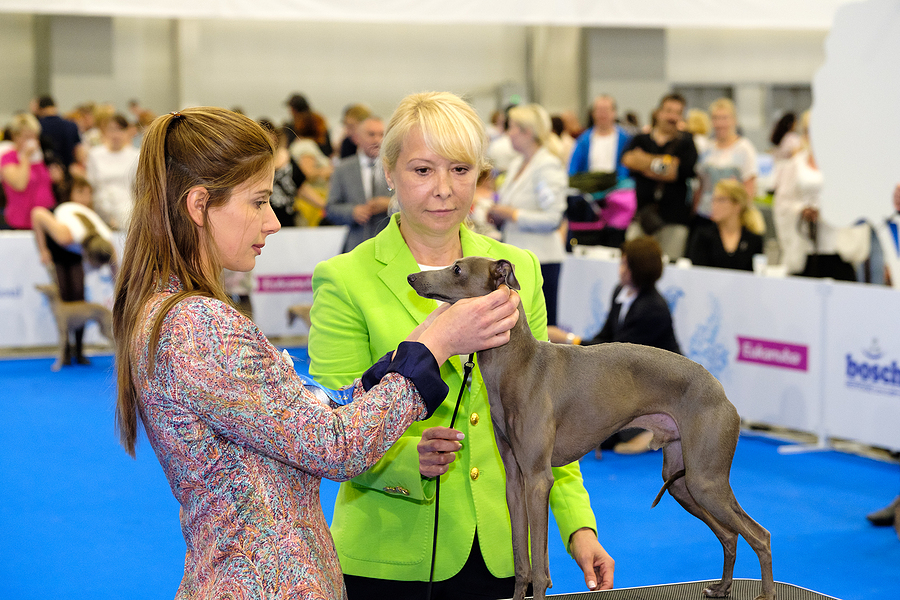A recent Saturday Night Live skit—“Badminster Dog Show”—poked fun at a certain well-known dog show. “Contestants” from the “Non-Walking Group,” “Shaking Group,” “Medical Group,” and “Mean Group” strutted their stuff.
But were they really having a good time? I’m not so sure.
Coming from a family who loves to laugh and tease, I realize that the SNL skit was coming from a place of finding humor in the ways dog behavior can unduly affect the lives of pet parents. From that perspective, there was a lot I appreciated about it. However, as an animal trainer and behavior consultant, some of the things I saw regarding the severe level of fear, anxiety, and stress (FAS) present in some of the dogs took away from the enjoyment of watching it.
For the good of dogs everywhere and their people, I’d like to offer some observations and takeaways:
- Dogs don’t like being picked up and placed on an elevated surface, especially if it’s slippery and doesn’t allow a means of easy escape. The dogs lifted onto the table were in a high state of FAS and either froze in fear or attempted to escape.
- This was made worse when handling was done in a manner that prioritized the objective task (such as examining the teeth) over the dogs’ comfort level and physical and emotional safety. Based on body language, there were numerous times in the skit that the dogs appeared distressed.
- Because animals are constantly learning, experiences in which more importance is placed on “getting the job done” than on the animal’s emotional wellbeing will make it much more likely that the dogs will display heightened FAS in similar circumstances in the future, resulting in potential negative associations with experiences such as being picked up, being examined on an elevated surface (the exam table at the veterinary clinic, for instance), or being looked at, touched, or otherwise handled by different people.
- The dogs’ comfort level could have been met by pairing rewards with the experience beforehand to prepare them through ongoing exposure, so they could learn to be comfortable and carefree with standing for a physical exam on an elevated surface. When dogs don’t learn what to expect beforehand, they may freeze in fear or struggle to escape, causing a progression to aggression that makes care more stressful and dangerous for everyone involved.
- Small but easy modifications such as providing nonslip surfaces or allowing the dogs to choose the area where they feel most comfortable have the potential to make a big impact on a dog—in a positive way. When an elevated surface is necessary, they have a stable, nonslip place to stand so they don’t experience “slip-and-scare” moments. Offering comfortable places with ample traction and ideally allowing the animal to move voluntarily into this place or desired position on their own can be achieved through enticements such as treats, toys, a comfortable resting surface, or a warm towel. Those things encourage animals to participate in care or activities. When care is forced, we risk a negative learning experience.
- It’s important to take early steps to prevent fear progression and address even early signs of FAS before they progress to the point that the dog feels the need for protection from what seems like a threatening situation.
- Avoid looming or leaning over an animal, reaching above them or toward the head or face, and making direct eye contact. For instance, the dog in the “Non-Walking Group,” already in a state of heightened FAS, was put in a position to bite by having his face and mouth restrained and the person directly bending down to face him with what to the dog was an eye-to-eye stare, an action that he likely perceived as a predatory threat. The camera went off the dog just as his mouth was tightening and body drawing back into what was likely going to be a defensive lunge and snap or bite as other attempts to avoid the social and physical threat and to voice his distress were ignored.
- In all situations, whether real-life interaction and care in the home, at the vet, groomer, a dog show, or yes, in a comedy skit, it’s important to pay attention to the animal’s emotional state. A negative learning experience can hinder future happy interaction and care attempts. It’s in this type of situation, when the animal’s needs go unattended and FAS progresses, that the dog may progress to a bite.
- When animals’ fears go unnoticed for too long, their initial polite requests can turn into desperate attempts to break free and feel safe. It’s our responsibility as their caretakers to always pay attention to how our dogs feel, by noting their body language and providing the element of choice that allows them to willingly participate in interactions and care, but never forces a situation, which can heighten risk of an aggressive response and difficulty gaining the animal’s cooperation with future care.
This article was reviewed/edited by board-certified veterinary behaviorist Dr. Kenneth Martin and/or veterinary technician specialist in behavior Debbie Martin, LVT.








